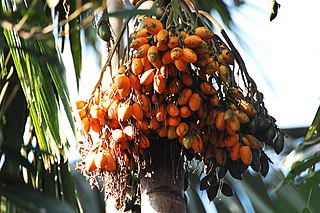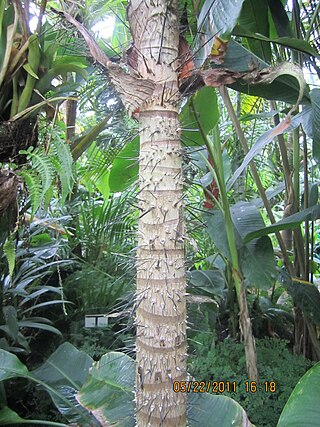Related Research Articles

Archontophoenicinae is a botanical subtribe consisting of four genera of palms, namely Archontophoenix from Queensland and New South Wales and Actinokentia, Chambeyronia and Kentiopsis from New Caledonia. Phylogenetic relationships between the four genera are unresolved.

Rhopalostylidinae is a botanical subtribe consisting of two genera of palms from Australia and New Zealand, Hedyscepe and Rhopalostylis. These two genera were formerly included in Archontophoenicinae, to which they are morphologically similar, until a recent revision.

Corypheae is a tribe of palm trees in the subfamily Coryphoideae. In previous classifications, tribe Corypheae included four subtribes: Coryphinae, Livistoninae, Thrinacinae and Sabalinae, but recent phylogenetic studies have led to the genera within these subtribes being transferred into other tribes. Tribe Corypheae is now restricted to the genus Corypha alone.

Areceae is a palm tree tribe in the family Arecaceae.

Arecinae is a palm tree subtribe in the tribe Areceae.

Dypsidinae is a subtribe of plants in the family Arecaceae.

Ptychospermatinae is a palm tree subtribe in the tribe Areceae.

Caryoteae is a tribe within the palm family Arecaceae, distributed across Southeast Asia, from southern India and Sri Lanka east to Vanuatu and northernmost Queensland, Australia. It was historically classified under the subfamily Arecoideae due to its inflorescences, which resemble those of the tribe Iriarteeae, and its flowers arranged in triads, a common trait in Arecoideae. However, phylogenetic studies based on DNA repeatedly link Caryoteae to subfamily Coryphoideae. Caryoteae do have leaves with induplicate folds, a feature found in most Coryphoid palms, but unlike most Coryphoideae, the leaves are pinnate or bipinnate (Caryota). Phoenix is the only other Coryphoid genus with induplicate, pinnate leaves.

Iriarteeae is a palm tribe in the subfamily Arecoideae.

Chamaedoreeae is a palm tribe in the subfamily Arecoideae. It has five genera.

Borasseae is a tribe in the palm subfamily Coryphoideae. The tribe ranges from southern Africa and Madagascar north through the Arabian Peninsula to India, Indochina, Indonesia and New Guinea. Several genera are restricted to islands in the Indian Ocean. The two largest genera, Hyphaene and Borassus, are also the most widespread.

Chuniophoeniceae is a tribe of palms in subfamily Coryphoideae of plant family Arecaceae. The four genera within the tribe are morphologically dissimilar and do not have overlapping distributions. Three of the genera are monotypic, while the fourth genus (Chuniophoenix) has three species.

Trachycarpeae is a tribe of palms in subfamily Coryphoideae of the plant family Arecaceae. It has the widest distribution of any tribe in Coryphoideae and is found on all continents, though the greatest concentration of species is in Southeast Asia. Trachycarpeae includes palms from both tropical and subtropical zones; the northernmost naturally-occurring palm is a member of this tribe. Several genera can be found in cultivation in temperate areas, for example species of Trachycarpus, Chamaerops, Rhapidophyllum and Washingtonia.

Phytelepheae is a tribe of plants in the subfamily Ceroxyloideae of the family Arecaceae.

Clinospermatinae is a subtribe of plants in the family Arecaceae.

Basseliniinae is a subtribe of plants in the family Arecaceae.

Carpoxylinae is a subtribe of plants in the family Arecaceae.

Pelagodoxeae is a tribe of plants in the family Arecaceae found in Oceania, namely in New Guinea and the Marquesas Islands. The tribe has two monotypic genera, which are:
Attaleinae is a subtribe of plants in the family Arecaceae. Genera in the subtribe, the majority of which are found in South America, are:

Genera Palmarum is a botany reference book that gives a detailed overview of the systematic biology of the palm family (Arecaceae). The first edition of Genera Palmarum was published in 1987. The second edition was published in 2008, with a reprint published in 2014. Genera Palmarum is currently the most detailed monograph on palm taxonomy and systematics.
References
- ↑ "Kew Magazine Photography". Kew Royal Botanic Gardens official website. Board of Trustees of the Royal Botanic Gardens, Kew. Archived from the original on 7 October 2012. Retrieved 18 April 2011.
- 1 2 "Genera Palmarum: the Evolution and Classification of Palms Edition 2 – Project Completed". Kew Royal Botanic Gardens official website. Board of Trustees of the Royal Botanic Gardens, Kew. Archived from the original on 5 December 2009. Retrieved 18 April 2011.
- ↑ "Dransfield, John". Royal Botanic Gardens, Kew. Archived from the original on 20 January 2012.
- ↑ "Fairchild Medal". National Tropical Botanical Garden. Retrieved 15 November 2023.
- ↑ "Recipients of the Linnean Medal". The Linnean Society of London official website. The Linnean Society of London. Archived from the original on 27 May 2015. Retrieved 27 May 2014.
- ↑ Volume 11.05 Special Edition · May 2023 · Newsletter of the IPS
- ↑ Sands, Martin (1978). "News of Kewites at home and abroad in 1977". The Journal of the Kew Guild. 10: 607–608 – via ISSUU.
- ↑ Harold Emery Moore; John Dransfield (1979). The typification of Linnean palms. International Bureau for Plant Taxonomy and Nomenclature. Retrieved 18 April 2011.
- ↑ John Dransfield (1979). A manual of the rattans of the Malay Peninsula. Forest Dept., Ministry of Primary Industries, Malaysia. Retrieved 18 April 2011.
- ↑ John Dransfield (1984). The rattans of Sabah. Forest Dept. Sabah. ISBN 9780591134841 . Retrieved 18 April 2011.
- ↑ John Dransfield (1986). Palmae. CRC Press. ISBN 978-90-6191-329-0 . Retrieved 18 April 2011.
- ↑ Natalie W. Uhl; John Dransfield; Harold Emery Moore (1987). Genera Palmarum: a classification of palms based on the work of Harold E. Moore, Jr. L.H. Bailey Hortorium. ISBN 978-0-935868-30-2 . Retrieved 18 April 2011.
- ↑ John Dransfield; Dennis Victor Johnson; Hugh Synge (November 1988). The palms of the New World: a conservation census. IUCN. ISBN 978-2-88032-941-9 . Retrieved 18 April 2011.
- ↑ John Dransfield (1992). The rattans of Sarawak. Royal Botanic Gardens, Kew. ISBN 978-0-947643-41-6 . Retrieved 18 April 2011.
- ↑ John Dransfield; Henk Beentje (1995). The palms of Madagascar. Royal Botanic Gardens and the International Palm Society. ISBN 978-0-947643-82-9 . Retrieved 18 April 2011.
- ↑ A. N. Rao; V. Ramanatha Rao; J.T. Williams, eds. (1998). Priority species of bamboo and rattan (PDF). Bioversity International. ISBN 978-92-9043-491-7 . Retrieved 18 April 2011.
- ↑ John Dransfield (15 January 2000). Corybas West of Wallace's Line. Royal Botanic Gardens, Kew. ISBN 978-1-84246-226-3 . Retrieved 18 April 2011.
- ↑ Rafaël Govaerts; John Dransfield (2005). World checklist of palms. Royal Botanic Gardens, Kew. ISBN 978-1-84246-084-9 . Retrieved 18 April 2011.
- ↑ John Dransfield (2006). Field guide to the palms of Madagascar. Royal Botanic Gardens, Kew. ISBN 978-1-84246-157-0 . Retrieved 18 April 2011.
- ↑ William J. Baker; John Dransfield (December 2006). Field guide to the palms of New Guinea. Royal Botanic Gardens, Kew. ISBN 978-1-84246-138-9 . Retrieved 18 April 2011.
- ↑ John Dransfield; Natalie W. Uhl (2008). Genera Palmarum: the evolution and classification of palms. Kew Pub. ISBN 978-1-84246-182-2 . Retrieved 18 April 2011.
- ↑ Baker, William J.; Dransfield, John (2016). "Beyond Genera Palmarum: progress and prospects in palm systematics". Botanical Journal of the Linnean Society. 182 (2): 207–233. doi: 10.1111/boj.12401 .
- ↑ International Plant Names Index. J.Dransf.